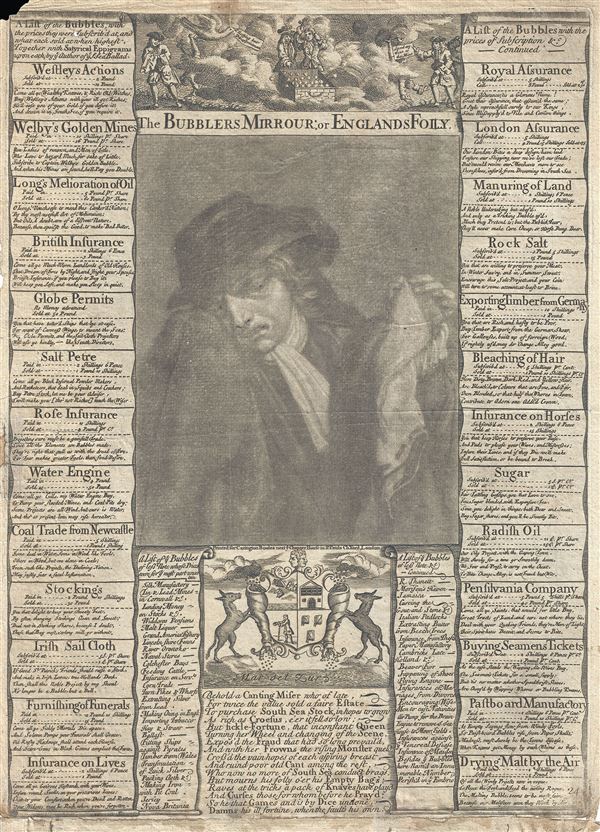This item has been sold, but you can get on the Waitlist to be notified if another example becomes available, or purchase a digital scan.
1766 Bowles Broadside Satirizing the South Sea Bubble
BubblersMirrourEnglandsFolly-bowles-1766
Title
1766 (undated) 14 x 10 in (35.56 x 25.4 cm)
Description
Following the crash of the South Sea Company, in 1720, many Londoners were ruined. Bowles no doubt hoped to capitalize on general interest in bubble economics as well as present his own ideas regarding their folly. Broadsides like this would typically be sold for perusal in bars and coffee shops where patrons would gather around a table to discuss the news represented or laugh (or cry) at the publication's wit. As such, few survive and those that do are typically in poor condition.
The present example features a dramatic early mezzotint of a weeping man deep in mourning whipping tears with his cloak and a handkerchief - certainly a disappointed South Sea investor. The caption reads:
Behold a canting Miser who of late,The document is surrounded by a list of some 28 bubbles, identifying both the purchase price and the sale price. Shares of the Pennsylvania Company, for example, rose from £5 5s to £40! Reading through the list, which includes such oddities as 'Bleaching of Hair,' 'Radish Oil,' and 'Manuring of Land,' one might assume the list fictional, but in fact most, if not all, of these were actual joint-stock ventures that rose simultaneously with the behemoth South Sea Company.
For twice the value sold a faire Estate
To purchase South Sea Stock, in hose to grow
As rich as Croesus, e'er it fell so low;
But fickls-Fortune, that inconstant Queen
Turning her Wheel and changing of the Scene,
Expos'd the Fraud that had so long prevailed…
An engraving at the top of the broadside illustrates a chest of coin floating away into the clouds. At the bottom, another engraving takes the form of an armorial crest - a mockery of England own royal crest. Here the noble Lion and Unicorn are replaced by asses. These support inverted cornucopias, into which rains wealth from the clouds, and which themselves which discharge into the notably Spanish 'Mar del Zur.'
Bowles' broadside must have proven popular. After Bowles initially printed this in 1720, his successor, Henry Carington Bowles, followed up with a reissue in 1766 - the present example. A third and final edition was issued on woven paper around 1800. The present example is on laid paper with an elaborate crown and crest watermark associated with an unknown papermaker active in London c. 1736.
Cartographer
The Bowles Family (fl. c. 1714 - 1832) were publishers and map sellers active in London from c. 1714 to c. 1832. The firm, under Thomas Bowles (fl. 1714 - 1763), John Bowles (1701 - 1779), Carrington Bowles (1724 - 1793), and as Bowles and Carver (fl. 1794 - 1832), produced a massive corpus of work that included numerous atlases, pocket maps, and wall maps. The Bowles publishing tradition was kept alive for four generations, starting with Thomas Bowles, a print engraver active in the late 17th century. His son, Thomas Bowles II, produced the firm's first maps at St. Paul's Churchyard, London. Thomas's brother, John Bowles (a.k.a. 'Old John Bowles' or 'Black Horse Bowles'), was also an active publisher established at no. 13 Cornhill. He is credited as one of the first publishers of William Hogarth's works. There, John's son, Carrington Bowles, was introduced to the trade. Carrington took over the Cornhill bookshop and eventually merged it with his uncle's shop in St. Paul's Churchyard. On Carrington's 1793 death, the business was passed to his son Henry Carrington Bowles (1763 - 1830), who partnered with his father's former apprentice Samuel Carver (1756 - 1841), renaming the firm 'Bowles and Carver'. Under this imprint, the firm continued to publish maps and atlases until 1832. Henry Carrington Bowles died in 1830, but Samuel Carver, himself in advanced years and poor health, kept it going for another 2 years before closing the business. More by this mapmaker...

